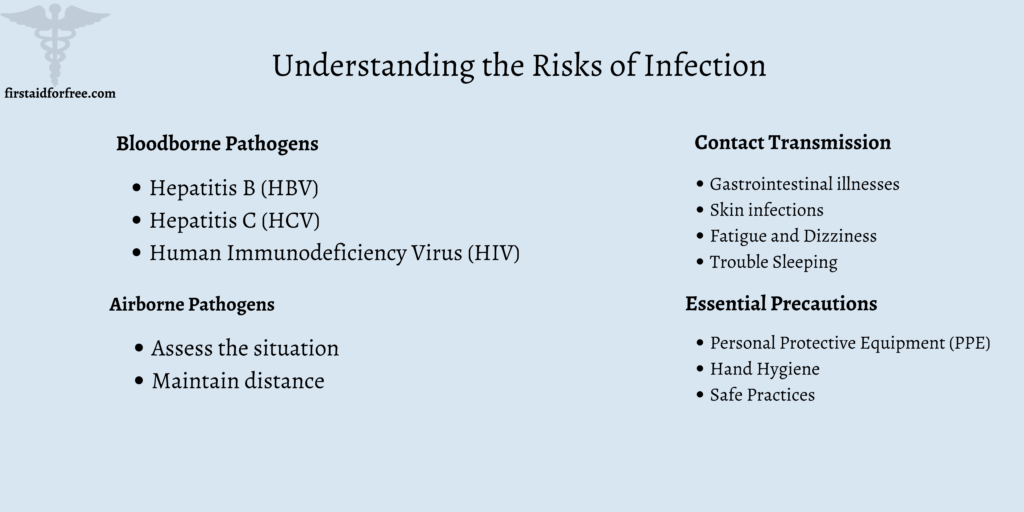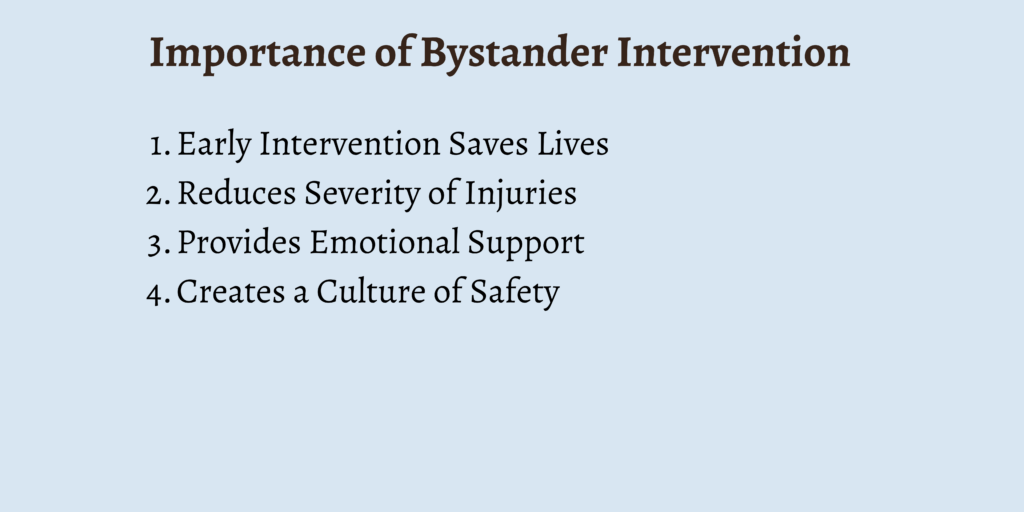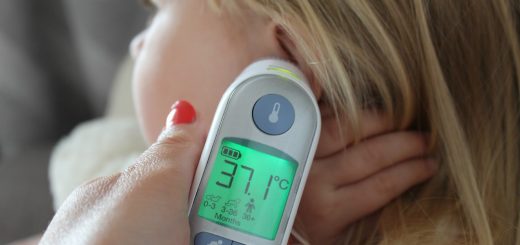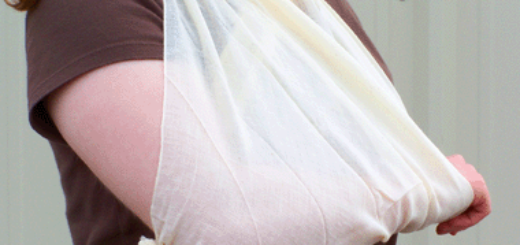What is Your Risk of Getting Infected with a Disease while Giving First Aid Care?
When someone is injured, our first instinct is to help them, but we fear getting infected, right?
It is a common concern for all; however, helping someone in need minimizes the risk and can save lives.
To answer the question, “What is your risk of getting infected with a disease while giving first aid care,” we have shared this article, which specifically explains the issue.
We will cover the risks of infection, essential precautions, and the importance of bystander intervention.
If you are curious, keep reading!
Understanding the Risks of Infection

Helping someone in need is a natural human instinct. However, the fear of contracting a disease while administering first aid can sometimes hold people back. Let’s know about the actual risks of infection.
Bloodborne Pathogens
First and foremost, the biggest concern lies with bloodborne pathogens. These are viruses or bacteria that are transmitted through direct contact with infected blood or bodily fluids. Some examples include:
- Hepatitis B (HBV): This virus attacks the liver and can lead to chronic infection.
- Hepatitis C (HCV): Another liver disease, HCV, can cause long-term damage, including cirrhosis
- Human Immunodeficiency Virus (HIV): The virus responsible for AIDS, HIV attacks the immune system.
While the potential consequences of contracting these diseases are severe, the actual risk of transmission during first aid is very low. Here’s why:
- Intact Skin: The virus needs a direct pathway into your bloodstream to infect you. Healthy, unbroken skin provides excellent protection.
- Minimal Contact: Most first-aid situations involve brief contact with blood. Techniques like applying pressure with a clean cloth further minimize risk.
- Modern First Aid: The emphasis on using disposable gloves and proper wound dressings significantly reduces the chance of contact.
Even though the risk is low, it’s not zero. If you experience a needlestick injury or significant blood contact with an open wound, seek immediate medical attention.
Airborne Pathogens
Another category of concern you should know about is airborne pathogens – illnesses spread through coughs and sneezes. These include the common cold, flu, and even more serious infections like tuberculosis. The risk here depends largely on the situation.
If you’re simply applying a bandage to a minor cut on someone who feels well, the risk is minimal. However, if you’re assisting someone with a respiratory illness who is actively coughing or sneezing, the risk increases.
Here’s how to minimize your risk:
- Assess the situation: If the person seems well, the risk is likely low. In cases of severe coughs or respiratory distress, consider using a face mask for additional protection.
- Maintain distance: Standing a safe distance can significantly reduce exposure to airborne droplets.
Contact Transmission
Contact transmission occurs when you touch a contaminated surface or bodily fluid and then touch your eyes, nose, or mouth. This can spread infections like:
- Gastrointestinal illnesses: These include illnesses like rotavirus and norovirus, commonly spread through contact with contaminated surfaces or feces.
- Skin infections: Examples include impetigo and ringworm, which can be transmitted by touching infected skin or surfaces.
Here’s how to minimize the risk:
- Wash your hands thoroughly: This is the single most effective way to prevent contact transmission.
- Use gloves: If you’re cleaning up vomit or other bodily fluids, wear disposable gloves.
- Practice good hygiene: Avoid touching your face unnecessarily, especially after providing first aid.
Essential Precautions
The benefits of providing first aid far outweigh the minimal risk of infection. However, taking a few simple precautions can further reduce that risk and ensure your own safety. These are a few essential practices for safe first aid:
Personal Protective Equipment (PPE)
Gloves: Your primary defense against bloodborne pathogens and contact transmission.
- Types of gloves: Non-sterile disposable gloves are sufficient for most first-aid scenarios. For situations involving high-risk fluids, consider using sterile gloves. Pinch the cuff of the glove and pull it onto your hand, ensuring it covers your wrist. Repeat for the other hand.
- Taking off gloves: Pinch the outside of the glove at the wrist and peel it off, turning it inside out as you remove it. Discard both gloves in a lined trash bin. Wash your hands immediately after.
Face Masks and Eye Protection: While not always necessary, these provide additional protection in specific situations:
- CPR: Use a face shield or CPR mask with a one-way filter valve to minimize exposure to mouth-to-mouth contact.
- Someone Coughing or Sneezing: If you’re close to someone with a respiratory illness, a surgical mask can offer some protection from airborne droplets.
- Blood Sprays: In scenarios with a high risk of blood splatter (e.g., severe injuries), consider using a face shield or goggles for eye protection.
Hand Hygiene
Washing your hands is the most effective way to prevent the spread of germs, both for yourself and the person you’re helping.
- Washing with soap and water: This is the preferred method. Use warm water and plenty of soap, lathering for at least 20 seconds, paying close attention to your palms, backs of hands, fingertips, and under your nails. Rinse thoroughly and dry with a clean paper towel.
- Hand sanitizer: If soap and water are unavailable, use an alcohol-based hand sanitizer with at least 60% alcohol content. Apply enough to cover all surfaces of your hands and rub them together until they feel dry.
Safe Practices
Beyond PPE and hand hygiene, here are some additional practices to make first aid even safer:
- Universal Precautions: Treat all blood and bodily fluids as potentially infectious, regardless of the person’s medical history. This ensures you consistently maintain a high level of protection.
- Avoiding Direct Contact: Minimize unnecessary contact with wounds or bodily fluids. Use clean dressings or clothes to apply pressure or control bleeding.
- Proper Disposal of Contaminated Materials: Disposable gloves, used dressings, and other contaminated materials should be disposed of in a lined trash bin. Needles or syringes require special disposal containers to prevent needle stick injuries.
Importance of Bystander Intervention

In many emergency situations, bystander intervention, the act of a witness taking action to help someone in need, can make a critical difference. Reasons why it’s important to step up and offer assistance:
- Early Intervention Saves Lives: The quicker a person receives medical attention, especially for life-threatening injuries or illnesses, the better their chances of survival and recovery.
- Reduces Severity of Injuries: Immediate first aid measures like applying pressure to bleeding wounds or stabilizing fractures can minimize tissue damage and blood loss, leading to better long-term outcomes.
- Provides Emotional Support: Being injured or ill can be a frightening experience. Your presence and actions can offer comfort and reassurance to the person in need until help arrives.
- Creates a Culture of Safety: When bystanders are willing to intervene, it sends a message that helping others is valued within the community. This can encourage more people to learn first aid and feel confident acting in emergencies.
FAQs
Is there a high risk of getting infected while giving first aid?
No, the risk is generally very low, especially with proper precautions like wearing gloves and washing hands.
What should I do if I accidentally get pricked by a needle during first aid?
Seek immediate medical attention. Early treatment can significantly reduce the risk of infection.
I want to help in emergencies, but I’m worried about getting sued. Do Good Samaritan Laws protect me?
Yes, most countries have laws protecting those who act in good faith to help others during emergencies. These laws offer legal protection from liability if your actions, even if unsuccessful, were intended to be helpful.
Conclusion
We hope this article helped you understand that helping an injured person is necessary; however, there are some essential precautions you should be aware of and must follow to keep yourself safe.





